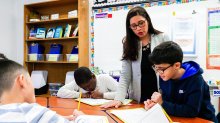Driving Deep Reading Comprehension in K–5
This five-phase reading strategy exposes every student to challenging texts—and has dramatically improved reading comprehension at a school in the Bronx.
Your content has been saved!
Go to My Saved Content.Collaborative reading is one of several strategies at Concourse Village Elementary School (CVES) that are meant to incorporate literacy into all aspects of the curriculum. The approach, spearheaded by Alexa Sorden, the school’s founding principal and a former literacy coach, is a marriage of shared reading—students read a text together, guided by the teacher—and close reading, which has students work independently and in small groups to produce a critical analysis of a text.
Classes in all grades in the pre-K to 5 school spend 15 to 20 minutes every day deconstructing an above-grade-level text of up to 150 words. The approach breaks down the reading process into five phases that emphasize repeated exposure to the text to drive deep comprehension: understanding the main idea, annotating the text, identifying key ideas and details, dissecting the author’s craft, and summarizing (download a PDF of the five phases). Because the reading of a single, challenging text is scaffolded over five days, students gradually develop a rich, portable methodology for decoding difficult materials.
Getting Started
Choosing a text: Collaborative reading texts—decided in advance by teacher teams for every six-week module—are either excerpts from fiction books or nonfiction texts that impart information.
Fiction passages highlight literary elements that may be challenging, like figurative language or themes. In kindergarten, teachers choose nursery rhymes to focus on rhyming, as well as particular messages, like optimism—a core value of the school.
Informational texts are often supplemental texts related to the other subjects that students are studying. For example, it can be difficult for fifth-grade students to understand how the Age of Exploration led to the development of capitalism, so fifth graders analyze a supplemental text on the subject through the collaborative reading process.
At the beginning of the week, K–5 students receive a handout with the collaborative reading text, along with a list of vocabulary words and questions that get students thinking critically about their materials.
Peer learning and student facilitators: Every K–5 class has a student facilitator for the year, chosen for his or her strong reading fluency. Student facilitators take the collaborative reading text home a few days prior to reading it at school so that they’re able to support their peers—guiding them to “use extra evidence” or asking them why they chose a certain answer. In kindergarten, instead of one student facilitator for all five phases of the collaborative reading process, there is one student facilitator for each phase.
“Students tend to listen more when it’s one of their peers who is actually providing support,” says Raquel Linares, a fifth-grade teacher.
Understanding the Gist
In the first phase of deconstructing the chosen piece, students skim the text and put a question mark next to words they don’t understand. The student facilitator introduces the focus: understanding the gist of the text.
Next, the teacher models what fluent reading looks like in front of the class, reading aloud with a focus on intonation and elocution. Students identify and discuss the meaning of unknown words.

The class reads the text aloud in unison followed by the student facilitator reading the phase one question: “Which sentence best describes the main idea of the excerpt?” After students discuss and answer the question in small groups, they share their responses with the whole class.
The opportunity to discuss the core of the text multiple times with their peers creates confidence in new readers, demonstrates that all readers sometimes struggle, and enables individuals to gather knowledge and new perspectives from the whole group.
“My favorite thing about collaborative reading is that we all hear other people’s ideas, and we have a chance to build up on a bigger idea,” says fifth-grade student Mia.
Annotating
The student facilitator introduces the focus of phase two of the reading process: annotating the text and highlighting details that support the main idea. Asking questions and highlighting important information—students need to learn how to discriminate crucial information from secondary information—promote a deeper understanding of the language.
The whole class then reads the text aloud in unison—a step they repeat in each phase. Students annotate the text on their own, discuss in their group, and share with the class.
When annotating a fictional story, students focus on elements like plot, character, and conflict. When annotating informational texts, they look at things like illustrations and captions. Students focus on using one main annotation marking per week but can use others as well. For example, the focus might be to highlight details that answer a critical question or that support the main theme; they would mark those details with a “D” on the reading materials.
The second-grade to fifth-grade annotation markings build upon the markings used in pre-K to first grade.
Identifying Key Details
After the student facilitator kicks off the task, phase three focuses on identifying key details and ideas, aligning with the New York State Next Generation ELA Learning Standards, which require students to make inferences, support claims with textual evidence, and summarize.
The students read the text together, discuss the critical-thinking question in groups, and then share with the class. Daily group discussions allow students to build their communication and collaboration skills.
In kindergarten, students might develop and answer questions about the text, while in fifth grade, students might make inferences based on textual evidence. For example, when fifth-grade students read an excerpt from the novel Jazmin’s Notebook, they are asked to make inferences about the guidance counselor and her perception of Jazmin. Making claims supported by evidence is an important critical thinking and writing skill.
Analyzing the Author’s Craft
In phase four, students focus on deconstructing the author’s craft and motivations for writing.
In groups, students look at why the author chose certain words, phrases, or pictures and what messages those choices convey. Fifth-grade students, for example, are asked to consider how irony is being communicated in Jazmin’s Notebook through the name of the guidance counselor: Lillian Wise. In an informational text, students might look at what information the photos or infographics convey to add context to the material.
Deconstructing the writing process from the viewpoint of the author helps students understand how word choice, imagery, themes, and sentence structure inform the work. By focusing on word choice, students see that different words carry different connotations that affect the meaning and tone of the text. Group discussion allows students with a deeper understanding of the material to provide support to peers who may be struggling and exposes all students to perspectives they might not have considered.
Summarizing and Drawing Conclusions
The final phase centers around the second core standard: “Determine central ideas or themes of a text and analyze their development; summarize the key supporting details and ideas.” Each student writes a short summary of the text and draws conclusions. Summarizing helps students articulate their understanding in their own words. They also draw conclusions about the text in several ways, including examining the author’s motivations for the writing, making personal connections to the text, or answering questions about the text—skills that students need for all classes.
For example, fifth-grade students read a passage from Jazmin’s Notebook in which Lillian Wise, the guidance counselor, has enrolled a black student in classes that are not college preparatory courses, saying, “A person like yourself would be happier in the business world.” The student, Jazmin, pushes back and asks why she should not be included in college prep classes.
The students are asked to consider the broader consequences of Miss Wise’s expectations and Jazmin’s response.
The question serves two purposes: Students summarize the central theme and point to textual evidence to support their claims, and they consider the importance of self-advocacy, a skill their teachers want them to develop as they leave Concourse Village for the next phase of their education.
“Reading is a lifelong skill across anything you do, anywhere you go,” says Sorden. “It’s important that our children are able to read very well when they walk out of here.”
